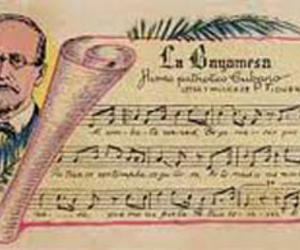"La Bayamesa," Cuba’s popular anthem
- Submitted by: manso
- Editorial Articles
- 04 / 08 / 2011

By: Rafael Lam. CUBA’s popular anthem "La bayamesa" emphasizes the romanticism of the Cuban sense of nationality. The story of how this song was created is as follows: Francisco Castillo called on the services of two of his friends to help him write a song of reconciliation, dedicated to wife, Luz Vázquez, who was estranged from him at the time.
Carlos Manuel de Céspedes (who later became known as the father of the country) helped him with the music and they used selected words by the poet José Fornaris. Then the tenor Carlos Pérez, with his guitar, offered to sing it as a serenade on March 27, 1891. That is its genuine history as found in the book Bayamo and recounted to me by my friend Lino Betancourt.
But songs, after their creation, take on a life of their own and, from around 1897 there was a flourishing of patriotic works with origins that can be traced back to 1830, and people began to sing décimas, guarachas and guajiras such as "La bandera cubana," "El combate del Mal Tiempo," "La Guerrilla," "Las penas de un deportado," "Cuba para los cubanos," and others.
Those were times in Latin America influenced by the French Revolution, when songs were composed in the style of Rouget de Lisle’s "La Marseillaise." Hence the veritable dawning of patriotic songs in Cuba, which culminated with "La bayamesa."
The book La música colonial cubana en las publicaciones periódicas (1812-1902), Zoila Lapique acknowledges that La bayamesa, despite having a persistent European melodic line, began to distinguish itself on account of a certain native tone in its music and text. "There are love songs which speak to us of the beauty and tenderness of Cuban women, of our green fields and eternally blue sky."
Alejo Carpentier addressed that theme in his book La música en Cuba, in which he explains, "Songs also appear with a more national character, like "La bayamesa," in the heat of events, destined to be transformed into a fundamental patriotic song."
And that was logical: the verses directed – before the revolution of 1868 – to a charming woman of Bayamo, would assume an unexpected value years later, given their allusion to the time when Bayamo was free of Spanish domination.
Three immortal symbols of the essentially Cuban from the colonial period have to be mentioned: "La bella cubana" (José White, 1853), the habanera "Tú" (Eduardo Sánchez de Fuentes, 1892, with words written in 1894 by his brother Fernando Sánchez de Fuentes) and "La bayamesa" (Francisco Castillo Moreno, José Fornaris and Carlos Manuel de Céspedes, 1851).
The three are hymns to love and struggle, because their literary romantic themes were replaced with revolutionary verses which exalted patriotic love and the courage of men and women who fought for the emancipation of Cuba.
Gonzalo Roig said one could almost foresee in the words of old Cuban songs the state of mind of the people, their sufferings and their desires. They revealed the pride of the Cuban people, as can be seen in Ernesto Lecuona’s "Siboney."
The romantic connotation of the verses and the melody of "La bayamesa" were understood as a patriotic anthem for its celebration of the tenderness of a woman native to a place like Bayamo and because its writers were outstanding revolutionaries who considered the song to have music full of delicacy and a profoundly felt and much loved theme.
In Cuba it was sung everywhere by the mambises (19th century independence fighters) and later traveled beyond national borders. Around 12 versions and paraphrases of "La bayamesa," were written, even in Spain. In other words, national songs have an international reach, as Nicolás Guillén said, "One has to move from the national to the universal."
Source: www.granma.cu/ingles/culture-i/7abril-La Bayamesa.html
Comments